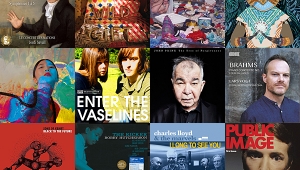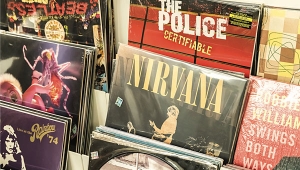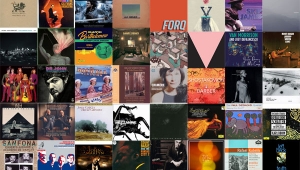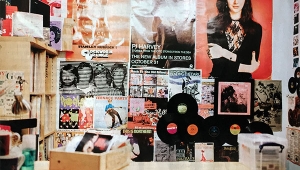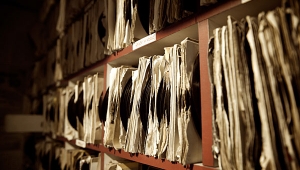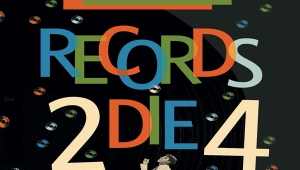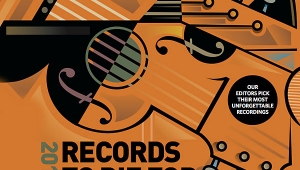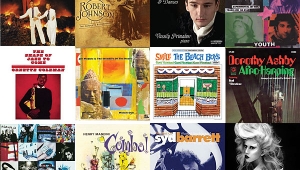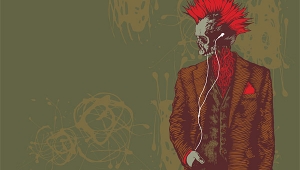| Columns Retired Columns & Blogs |
1999 Records To Die For Page 7
Mortimer H. Frank
MOZART: Symphonies 25, 29, 38, 40
Benjamin Britten, English Chamber Orchestra
London 444 323-2 (2 CDs). 1969-71/1998. David Harvey, Ray Munshill, prods.; Kenneth Wilkinson, Gordon Parry, engs. ADD. TT: 2:12:06
This reissue is a reminder of Britten's exceptional gifts as a conductor of music other than his own. Everything is neatly ordered but never rigid or bland, the rhythm being supple, the texture transparent, the pacing animated. This recording of Symphony 40 was, I believe, the first to include all of the score's six major repeats, extending its length nearly 40 minutes. In each of these performances melodies are beautifully sung without sounding sentimental; slow movements in particular never being permitted to drag. Significantly, too, Britten was aware of modern scholarship, playing appoggiaturas on the beat rather than as decorative grace notes. The sound—relatively close, accurate in timbre, and benefiting from the acoustics of The Maltings, Snape—is thoroughly contemporary. As a bargain reissue, this set is virtually a giveaway.
STRAVINSKY: The Fairy's Kiss, Symphony in C, Pulcinella, L'Histoire du soldat, Suite, Octet for Winds
Igor Stravinsky, Cleveland Orchestra, Instrumental Ensembles
Sony Masterworks Heritage MH2K 63325 (2 CDs). 1952-54/1998. Howard Scott, David Oppenheim, Arthur Fierro, prods.; Stephen Saper, Todd Whitelock, Charles Harbutt, reissue engs. ADD. TT: 2:34:16
Unlike Britten, Stravinsky rarely conducted music other than his own. Still, he was one of the most convincing exponents of his art and, typical of any first-rate interpreter, often changed his view of how it should be performed. Thus these recordings from the early '50s, although redone by the composer in stereo, are not redundant. Rather, they offer alternative compelling accounts of the music—sometimes a bit more relaxed, as in this earlier Symphony in C. Other times, however, as in the Octet and L'Histoire du soldat, the younger Stravinsky is more incisive. Indeed, L'Histoire is extraordinary, not only for its unmatched astringent bite, but also for the immediacy and richness of its sound—one of the most realistic monaural recordings I have ever heard. In fact, the engineering in all of these recordings is, for its time, ne plus ultra, and the Cleveland Orchestra and chamber ensembles respond to the composer's direction with virtuosic vibrance. Like nearly everything in Sony's Masterworks Heritage series, this set is a model of sonic restoration and imaginative, intelligent production.
RICHARD DAVIES: Telegraph
Flydaddy 16 (LP/CD). 1997. Richard Davies, Ronald Jones, prods.; Wes Naprstek, others, engs. AAA/AAD. TT: 38:18 (LP includes bonus 7" 45 with two additional songs)
This 34-year-old Australian expatriate now lives in Woodstock, New York and writes enigmatic, "under-the-radar" tunes outfitted with memorable lyrical images wrapped in ultramelodic, though dark, post-Abbey Road mid-tempo ear-candy sure to please lovers of cascading jingle-jangle guitars. Davies' deceptively simple arrangements don't waste notes. They mesmerize, using long stretches of repetitive guitar riffs supported by a springy bed of deep electric bass and kick drum. The heavy, soothing sound instantly pleases, creating a hypnotic sense of suspension. The effect is aided greatly by a bold, dynamic recording and a nuanced mix made up of fewer parts than it would at first seem. I played the CD version at HI-FI '98 in the Cary/Alón/Metronome room and watched as a roomful of audiophiles were instantly sucked in. When "Close to the Storyline" ended, Cary's Dennis Had exclaimed, "Hey, that was great! Play it again!" I gladly obliged. Get the thick vinyl. (What did you expect me to say?)
VAN MORRISON: The Complete New York Sessions '67
Get Back GET 501. (3 LPs). 1997. Bert Berns, prod.; Brooks Arthur, eng. AAA. TT: not listed
Van's extraordinary period of torment and growth, musical and otherwise, between Them and Astral Weeks, is documented in its recorded entirety on this three-LP set, which assembles everything the moody Mr. Morrison cut for Bang back in 1967. There's "Brown Eyed Girl" in the original, unexpurgated "makin' love" version, along with all of the songs on the original Bang Blowin' Your Mind and The Best of Van Morrison LPs. Also, for your amusement, is the tape Van handed to Bang prez Bert Berns' wife as part of the settlement that allowed him to move to Warner Bros. Berns had died of a heart attack shortly before the settlement and would probably have listened before accepting Van's tape. It contained nothing of commercial value. The multiple jams of fragmented songs with names like "Blow in Your Nose," "Ringworm," and "Nose in Your Blow" were of little interest then, but today add a small but important piece to the puzzle that is Van Morrison. Also included is an early version of the Astral Weeks classic "Madame George." Superb, dynamic sound.
PAUL SIMON: Songs from The Capeman
Warner Bros. 46814-2 (CD). 1997. Paul Simon, prod.; Bob Ludwig, eng. DDD. TT: 55:38
Before it closed, I attended two previews of Paul Simon's The Capeman, a short-lived Broadway musical featuring a stage band and vocals from salsa stars Ruben Blades and Marc Anthony. Because the show was widely regarded to be a musical success but a theatrical failure, I was very interested in this album. Having heard the music live, I can confirm that the songs featuring singers from the cast are startlingly accurate renditions of the show experience. Three selections are good enough to have become my standards for testing equipment. First, Ednita Nazario's close-miked "Sunday Afternoon" captures the richness of her vocal timbre, the syncopated beat of the stage-band ensemble, and the song's dense sadness. The second selection is the show-stopping "Time is an Ocean (of Endless Tears)" duet between the male leads. Good loudspeaker systems easily resolve the timbral differences between Ruben Blades' nasal, weary baritone and Marc Anthony's clear, youthful tenor when they are singing harmony.
ARTURO SANDOVAL/TITO PUENTE: Hothouse
N2K Encoded Music 10023-2 (CD). 1998. Phil Ramone, prod.; Eric Schilling, Ron Taylor, engs. DDD. TT: 54:06
Arturo Sandoval's Hothouse emerges from his long association with Dizzy Gillespie. This can be heard in the album's title track, a Tadd Dameron composition that Dizzy often included in his sessions. Michael Brecker's tenor-sax solo captures the song's bebop influences. Another great cut features singer Patti Austin's interpretation of the bolero "Only You," a great test of a system's ability to image her close-miked voice.
MOZART: Symphonies 25, 29, 38, 40
Benjamin Britten, English Chamber Orchestra
London 444 323-2 (2 CDs). 1969-71/1998. David Harvey, Ray Munshill, prods.; Kenneth Wilkinson, Gordon Parry, engs. ADD. TT: 2:12:06
This reissue is a reminder of Britten's exceptional gifts as a conductor of music other than his own. Everything is neatly ordered but never rigid or bland, the rhythm being supple, the texture transparent, the pacing animated. This recording of Symphony 40 was, I believe, the first to include all of the score's six major repeats, extending its length nearly 40 minutes. In each of these performances melodies are beautifully sung without sounding sentimental; slow movements in particular never being permitted to drag. Significantly, too, Britten was aware of modern scholarship, playing appoggiaturas on the beat rather than as decorative grace notes. The sound—relatively close, accurate in timbre, and benefiting from the acoustics of The Maltings, Snape—is thoroughly contemporary. As a bargain reissue, this set is virtually a giveaway.
STRAVINSKY: The Fairy's Kiss, Symphony in C, Pulcinella, L'Histoire du soldat, Suite, Octet for Winds
Igor Stravinsky, Cleveland Orchestra, Instrumental Ensembles
Sony Masterworks Heritage MH2K 63325 (2 CDs). 1952-54/1998. Howard Scott, David Oppenheim, Arthur Fierro, prods.; Stephen Saper, Todd Whitelock, Charles Harbutt, reissue engs. ADD. TT: 2:34:16
Unlike Britten, Stravinsky rarely conducted music other than his own. Still, he was one of the most convincing exponents of his art and, typical of any first-rate interpreter, often changed his view of how it should be performed. Thus these recordings from the early '50s, although redone by the composer in stereo, are not redundant. Rather, they offer alternative compelling accounts of the music—sometimes a bit more relaxed, as in this earlier Symphony in C. Other times, however, as in the Octet and L'Histoire du soldat, the younger Stravinsky is more incisive. Indeed, L'Histoire is extraordinary, not only for its unmatched astringent bite, but also for the immediacy and richness of its sound—one of the most realistic monaural recordings I have ever heard. In fact, the engineering in all of these recordings is, for its time, ne plus ultra, and the Cleveland Orchestra and chamber ensembles respond to the composer's direction with virtuosic vibrance. Like nearly everything in Sony's Masterworks Heritage series, this set is a model of sonic restoration and imaginative, intelligent production.
![]()
Michael Fremer
RICHARD DAVIES: Telegraph
Flydaddy 16 (LP/CD). 1997. Richard Davies, Ronald Jones, prods.; Wes Naprstek, others, engs. AAA/AAD. TT: 38:18 (LP includes bonus 7" 45 with two additional songs)
This 34-year-old Australian expatriate now lives in Woodstock, New York and writes enigmatic, "under-the-radar" tunes outfitted with memorable lyrical images wrapped in ultramelodic, though dark, post-Abbey Road mid-tempo ear-candy sure to please lovers of cascading jingle-jangle guitars. Davies' deceptively simple arrangements don't waste notes. They mesmerize, using long stretches of repetitive guitar riffs supported by a springy bed of deep electric bass and kick drum. The heavy, soothing sound instantly pleases, creating a hypnotic sense of suspension. The effect is aided greatly by a bold, dynamic recording and a nuanced mix made up of fewer parts than it would at first seem. I played the CD version at HI-FI '98 in the Cary/Alón/Metronome room and watched as a roomful of audiophiles were instantly sucked in. When "Close to the Storyline" ended, Cary's Dennis Had exclaimed, "Hey, that was great! Play it again!" I gladly obliged. Get the thick vinyl. (What did you expect me to say?)
VAN MORRISON: The Complete New York Sessions '67
Get Back GET 501. (3 LPs). 1997. Bert Berns, prod.; Brooks Arthur, eng. AAA. TT: not listed
Van's extraordinary period of torment and growth, musical and otherwise, between Them and Astral Weeks, is documented in its recorded entirety on this three-LP set, which assembles everything the moody Mr. Morrison cut for Bang back in 1967. There's "Brown Eyed Girl" in the original, unexpurgated "makin' love" version, along with all of the songs on the original Bang Blowin' Your Mind and The Best of Van Morrison LPs. Also, for your amusement, is the tape Van handed to Bang prez Bert Berns' wife as part of the settlement that allowed him to move to Warner Bros. Berns had died of a heart attack shortly before the settlement and would probably have listened before accepting Van's tape. It contained nothing of commercial value. The multiple jams of fragmented songs with names like "Blow in Your Nose," "Ringworm," and "Nose in Your Blow" were of little interest then, but today add a small but important piece to the puzzle that is Van Morrison. Also included is an early version of the Astral Weeks classic "Madame George." Superb, dynamic sound.
Also amazing: producer Bob Irwin's superb-sounding new remix to 2-track analog of Blowin' Your Mind (plus five outtakes) from the original 4-track, issued on Epic/Legacy.
![]()
Larry Greenhill
PAUL SIMON: Songs from The Capeman
Warner Bros. 46814-2 (CD). 1997. Paul Simon, prod.; Bob Ludwig, eng. DDD. TT: 55:38
Before it closed, I attended two previews of Paul Simon's The Capeman, a short-lived Broadway musical featuring a stage band and vocals from salsa stars Ruben Blades and Marc Anthony. Because the show was widely regarded to be a musical success but a theatrical failure, I was very interested in this album. Having heard the music live, I can confirm that the songs featuring singers from the cast are startlingly accurate renditions of the show experience. Three selections are good enough to have become my standards for testing equipment. First, Ednita Nazario's close-miked "Sunday Afternoon" captures the richness of her vocal timbre, the syncopated beat of the stage-band ensemble, and the song's dense sadness. The second selection is the show-stopping "Time is an Ocean (of Endless Tears)" duet between the male leads. Good loudspeaker systems easily resolve the timbral differences between Ruben Blades' nasal, weary baritone and Marc Anthony's clear, youthful tenor when they are singing harmony.
The final song is "Greyhound Bus," sung by Simon himself. Ever so slightly reminiscent of the country-music style of his Graceland ballads "Greyhound Bus" depicts a traveler trying to escape his past. Simon's light, smooth, lyric tenor turns harsh or is overrun by sibilants when played over loudspeakers with upper-midbass problems. In contrast, his voice and guitar flow and blossom on the best systems. This album captures outstanding ballad singing from some of the best salsa and popular singers of our time.
ARTURO SANDOVAL/TITO PUENTE: Hothouse
N2K Encoded Music 10023-2 (CD). 1998. Phil Ramone, prod.; Eric Schilling, Ron Taylor, engs. DDD. TT: 54:06
Arturo Sandoval's Hothouse emerges from his long association with Dizzy Gillespie. This can be heard in the album's title track, a Tadd Dameron composition that Dizzy often included in his sessions. Michael Brecker's tenor-sax solo captures the song's bebop influences. Another great cut features singer Patti Austin's interpretation of the bolero "Only You," a great test of a system's ability to image her close-miked voice.
For percussion fans like me, the pinnacle of this album is the duet between the legendary Tito Puente on timbales and Manuel Castrillo on congas. On the best loudspeaker systems, an image of the timbale drum kit is spread across the soundstage in three parts. Puente moves back and forth among the three kits. All orchestral elements—horn sections, congas, timbales—act as percussion instruments, mixing the explosive sounds of the drumhead, rim, and the wood of the drumstick with trumpet blasts. This selection has become my test standard for loudspeaker dynamic range, lack of compression, rhythm, and pace.
- Log in or register to post comments

